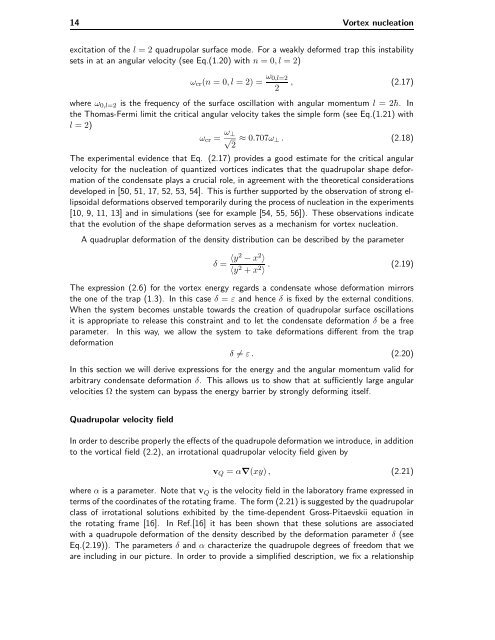Bose-Einstein Condensates in Rotating Traps and Optical ... - BEC
Bose-Einstein Condensates in Rotating Traps and Optical ... - BEC
Bose-Einstein Condensates in Rotating Traps and Optical ... - BEC
You also want an ePaper? Increase the reach of your titles
YUMPU automatically turns print PDFs into web optimized ePapers that Google loves.
14 Vortex nucleation<br />
excitation of the l =2quadrupolar surface mode. For a weakly deformed trap this <strong>in</strong>stability<br />
sets <strong>in</strong> at an angular velocity (see Eq.(1.20) with n =0,l =2)<br />
ωcr(n =0,l =2)= ω0,l=2<br />
,<br />
2<br />
(2.17)<br />
where ω0,l=2 is the frequency of the surface oscillation with angular momentum l =2¯h. In<br />
the Thomas-Fermi limit the critical angular velocity takes the simple form (see Eq.(1.21) with<br />
l =2)<br />
ωcr = ω⊥<br />
√2 ≈ 0.707ω⊥ . (2.18)<br />
The experimental evidence that Eq. (2.17) provides a good estimate for the critical angular<br />
velocity for the nucleation of quantized vortices <strong>in</strong>dicates that the quadrupolar shape deformation<br />
of the condensate plays a crucial role, <strong>in</strong> agreement with the theoretical considerations<br />
developed <strong>in</strong> [50, 51, 17, 52, 53, 54]. This is further supported by the observation of strong ellipsoidal<br />
deformations observed temporarily dur<strong>in</strong>g the process of nucleation <strong>in</strong> the experiments<br />
[10, 9, 11, 13] <strong>and</strong> <strong>in</strong> simulations (see for example [54, 55, 56]). These observations <strong>in</strong>dicate<br />
that the evolution of the shape deformation serves as a mechanism for vortex nucleation.<br />
A quadruplar deformation of the density distribution can be described by the parameter<br />
δ = 〈y2 − x2 〉<br />
〈y2 + x2 . (2.19)<br />
〉<br />
The expression (2.6) for the vortex energy regards a condensate whose deformation mirrors<br />
the one of the trap (1.3). In this case δ = ε <strong>and</strong> hence δ is fixed by the external conditions.<br />
When the system becomes unstable towards the creation of quadrupolar surface oscillations<br />
it is appropriate to release this constra<strong>in</strong>t <strong>and</strong> to let the condensate deformation δ be a free<br />
parameter. In this way, we allow the system to take deformations different from the trap<br />
deformation<br />
δ = ε. (2.20)<br />
In this section we will derive expressions for the energy <strong>and</strong> the angular momentum valid for<br />
arbitrary condensate deformation δ. This allows us to show that at sufficiently large angular<br />
velocities Ω the system can bypass the energy barrier by strongly deform<strong>in</strong>g itself.<br />
Quadrupolar velocity field<br />
In order to describe properly the effects of the quadrupole deformation we <strong>in</strong>troduce, <strong>in</strong> addition<br />
to the vortical field (2.2), an irrotational quadrupolar velocity field given by<br />
vQ = α∇(xy) , (2.21)<br />
where α is a parameter. Note that vQ is the velocity field <strong>in</strong> the laboratory frame expressed <strong>in</strong><br />
terms of the coord<strong>in</strong>ates of the rotat<strong>in</strong>g frame. The form (2.21) is suggested by the quadrupolar<br />
class of irrotational solutions exhibited by the time-dependent Gross-Pitaevskii equation <strong>in</strong><br />
the rotat<strong>in</strong>g frame [16]. In Ref.[16] it has been shown that these solutions are associated<br />
with a quadrupole deformation of the density described by the deformation parameter δ (see<br />
Eq.(2.19)). The parameters δ <strong>and</strong> α characterize the quadrupole degrees of freedom that we<br />
are <strong>in</strong>clud<strong>in</strong>g <strong>in</strong> our picture. In order to provide a simplified description, we fix a relationship




